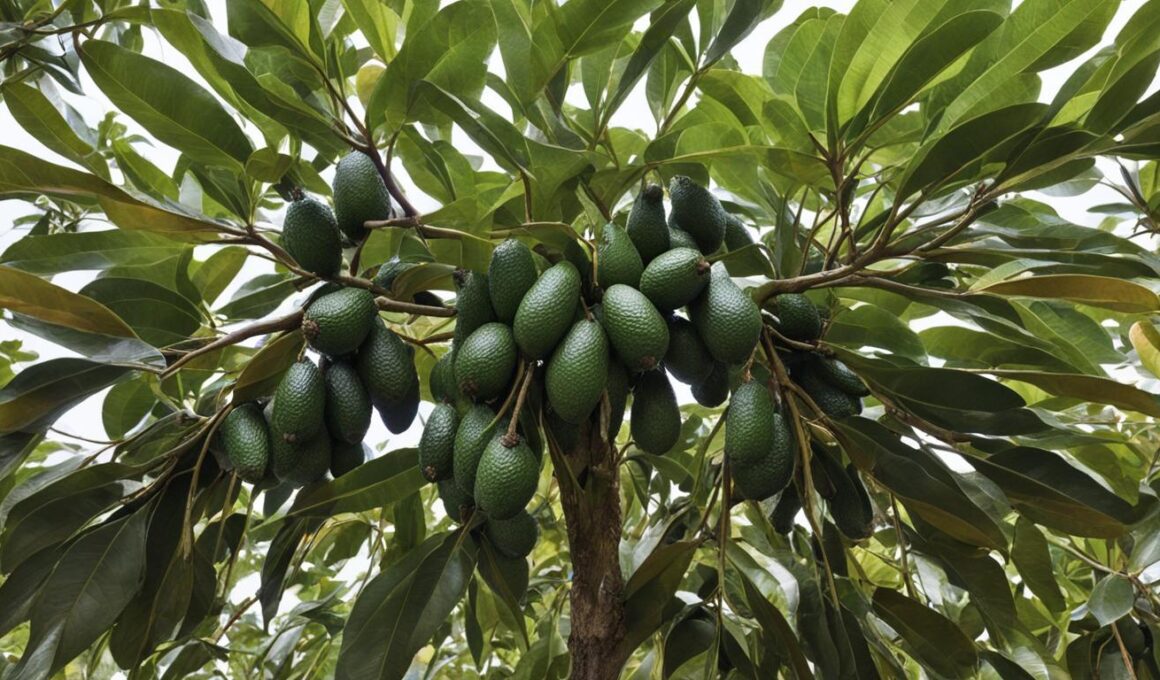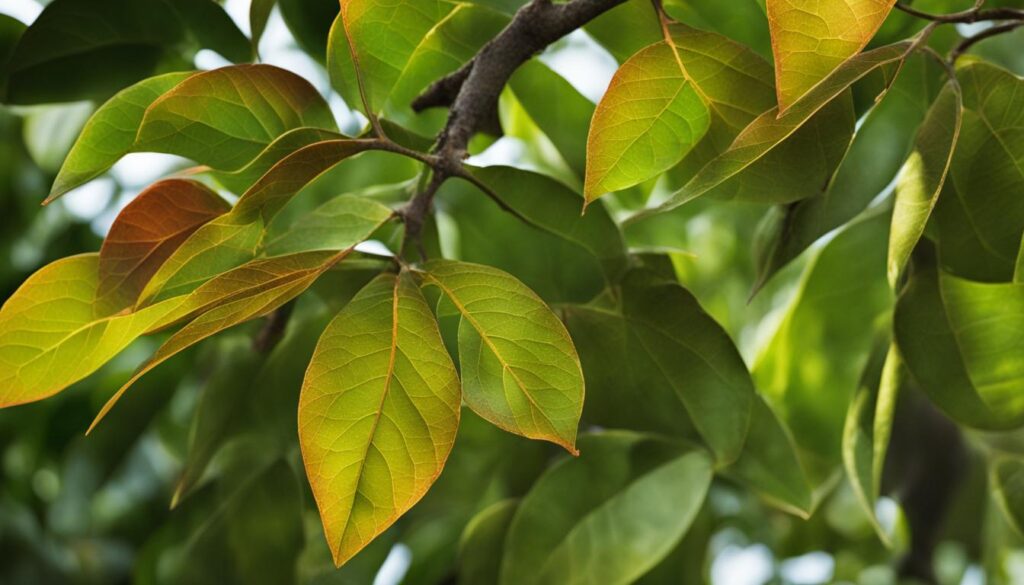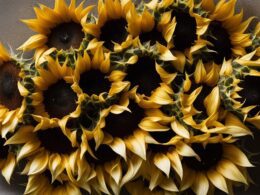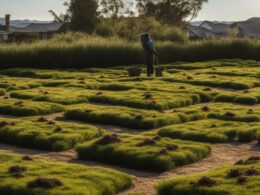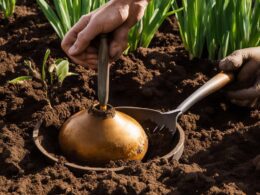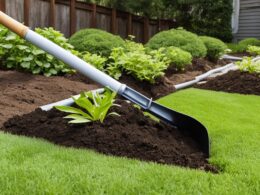Are the leaves of your avocado tree turning brown? Don’t worry, you’re not alone. Brown avocado leaves can be a common issue for avocado tree owners, but understanding the causes and implementing the right solutions can help restore your tree’s health and foliage.
There are several factors that can contribute to the browning of avocado leaves. One common culprit is dry air, especially during the fall and winter months when indoor humidity levels drop significantly. Avocado trees thrive in humid tropical climates, and when exposed to dry air, their leaves can lose water faster than they can replace it, resulting in browning and drying out.
Increasing the humidity around your avocado tree can help prevent further damage. Optimal humidity levels range from 45% to 55%. Using a humidifier or a humidity tray can be effective in raising the humidity levels. However, spraying the leaves with water is not recommended as it does not significantly increase humidity.
It’s important to note that increasing humidity will not reverse the damage on already browned leaves, but it can prevent future leaf browning. By providing the right growing conditions, you can help your avocado tree thrive and maintain its vibrant green foliage.
In the next sections, we will delve into other factors that can cause avocado leaf browning and how to address them. Understanding these factors will give you the knowledge you need to keep your avocado tree healthy and beautiful. Let’s get started!
Chloride-Induced Browning of Avocado Leaves
Avocado leaves browning can also be attributed to the presence of chloride in irrigation water, particularly in regions where the water source contains high levels of chloride, like Southern California. When avocado roots absorb water with elevated chloride content, they transport it to the leaves. As the water evaporates, the chloride residue remains, leading to toxic levels within the leaves. This chloride accumulation can result in the death of leaf tissue and subsequent browning, starting from the tips of the leaves.
Compared to other plants, avocado trees are more sensitive to chloride. Therefore, high-chloride levels in irrigation water can significantly impact the overall health and fruit production of avocado trees. To mitigate chloride-induced leaf browning, a technique called leaching can be employed. Leaching involves intentionally overwatering the soil to flush out the excess chloride. This can be achieved through deep and infrequent watering or by adding a leaching fraction to regular irrigation practices.
It’s crucial to monitor the amount of leaf burn caused by chloride and make necessary adjustments to watering practices accordingly. By implementing proper leaching techniques and managing chloride levels in irrigation water, you can help minimize the detrimental effects of chloride on avocado trees, allowing them to thrive and maintain healthy green foliage.
Other Factors Causing Avocado Leaf Browning
In addition to dry air and chloride-induced browning, avocado leaves can also turn brown due to other factors. Here are some common causes and how to address them:
- Underwatering: Avocado leaves may turn brown if the tree is not receiving adequate water. Check the soil moisture by conducting a moisture test. If the leaves are dry to the touch and wilt quickly, it is a sign of underwatering. Ensure proper watering by watering deeply and evenly, allowing the soil to dry out slightly between waterings.
- Fungal Infections: Avocado trees can be susceptible to fungal infections that cause brown spots on the leaves. Two common fungal diseases are Cercospora spot and Anthracnose. These diseases manifest as small dark brown spots with a yellow halo or circular brownish-black sunken spots on the leaves. To address fungal infections, maintain good tree hygiene by removing and destroying infected leaves, and applying appropriate fungicides as recommended by horticultural experts.
- Pest Infestations: Pests can also contribute to browning avocado leaves. Common pests include mites, scales, and thrips. These pests feed on the sap of the leaves, causing damage and discoloration. Using organic pest control methods or targeted insecticides can help mitigate pest infestations and prevent further leaf browning.
- Nutritional Deficiencies: Avocado trees require a balanced nutrient profile to maintain healthy foliage. Nutritional deficiencies, especially in iron, nitrogen, and zinc, can lead to brown avocado leaves. Conduct a soil test to assess nutrient levels and address any deficiencies by applying appropriate fertilizers or soil amendments as recommended by agricultural specialists.
By addressing these factors, you can prevent and minimize browning of avocado leaves, promoting the overall health and vitality of your avocado tree.
Conclusion
Avocado tree leaves turning brown can be a common issue caused by various factors, including dry air, chloride in irrigation water, fungal infections, pest infestations, and nutritional deficiencies. To prevent and mitigate browning of avocado leaves, it is crucial to take appropriate measures.
Increasing humidity levels around the avocado tree can help combat the effects of dry air. Employing leaching techniques, such as overwatering to flush out excess chloride, can address browning caused by chloride in irrigation water. Additionally, addressing fungal infections and pest infestations promptly is essential to maintain healthy leaves.
Furthermore, ensuring proper nutrient levels through soil testing and addressing any deficiencies is crucial in preventing brown avocado leaves caused by nutritional imbalances. Regularly monitoring the condition of the leaves and adjusting watering practices accordingly can aid in maintaining optimal growing conditions for healthier and thriving avocado trees.
Are Brown Leaves on Avocado Tree and Spots on Cucumber Leaves Related?
Yes, the brown leaves on avocado trees and spots on cucumber leaves are related. In both cases, the culprit may be a fungal disease known as anthracnose. Anthracnose is a common disease that affects many fruit and vegetable plants, and it is one of the main spots on cucumber leaves causes.





